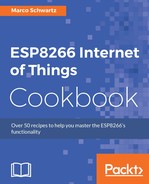In this chapter, we will cover:
- Introduction to MicroPython on the ESP8266
- Discovering the MicroPython language
- Running MicroPython on the ESP8266
- Controlling pins using MicroPython
- Reading data from a sensor using MicroPython
- Sending data to the cloud using MicroPython
- Troubleshooting common MicroPython issues
In this chapter, we will learn how to configure and control an ESP8266 board using MicroPython. MicroPython is one of the many programming languages that we can use to program the ESP8266 module. It is a lean and fast version of the Python 3 programming language and has several advantages over traditional programming languages such as C and C++.
The first advantage is that Python is a very well-known programming language. Therefore, there are numerous resources and libraries available online. This comes in handy when working on your open source projects.
Writing and debugging code using MicroPython is faster than when using other programming languages. In fact, it is about five times faster than C++. It is also easier to program using MicroPython because it is expressive and versatile, which makes it great for beginners.
MicroPython is great for low power applications, as the chip consumes less power when booting with MicroPython. This makes devices very energy efficient and ideal for low power applications that required a long battery life.
